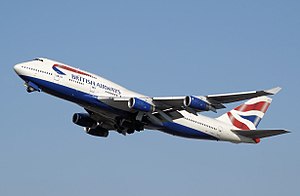Boeing 747-200
| Boeing 747 | |
|---|---|
 |
|
| Boeing 747-400 of British Airways, in January 2017 the type's largest operator | |
| Role | Wide-body jet airliner |
| National origin | United States |
| Manufacturer | Boeing Commercial Airplanes |
| First flight | February 9, 1969 |
| Introduction | January 22, 1970 with Pan American World Airways |
| Status | In service |
| Primary users |
British Airways Korean Air Lufthansa China Airlines |
| Produced | 1968–present |
| Number built | 1,528 as of December 31, 2016[update] |
| Unit cost |
747-100: US$24 million (1967)
747-200: US$39 million (1976) 747-300: US$83 million (1982) 747-400: US$228–260 million (2007) 747-8I: US$351.4 million 747-8F: US$352 million |
| Variants |
Boeing 747SP Boeing 747-400 Boeing 747-8 Boeing VC-25 Boeing E-4 |
| Developed into |
Boeing YAL-1 Boeing Dreamlifter |
The Boeing 747 is an American wide-body commercial jet airliner and cargo aircraft, often referred to by its original nickname, Jumbo Jet. Its distinctive "hump" upper deck along the forward part of the aircraft makes it among the world's most recognizable aircraft, and it was the first wide-body produced. Manufactured by Boeing's Commercial Airplane unit in the United States, the original version of the 747 was envisioned to have 150 percent greater capacity than the Boeing 707, one of the common large commercial aircraft of the 1960s. First flown commercially in 1970, the 747 held the passenger capacity record for 37 years. As of December 2016[update], the 747 has been involved in 60 hull-loss accidents resulting in 3,718 fatalities.
The four-engine 747 uses a double deck configuration for part of its length. It is available in passenger, freighter and other versions. Boeing designed the 747's hump-like upper deck to serve as a first class lounge or extra seating, and to allow the aircraft to be easily converted to a cargo carrier by removing seats and installing a front cargo door. Boeing did so because the company expected supersonic airliners (development of which was announced in the early 1960s) to render the 747 and other subsonic airliners obsolete, while the demand for subsonic cargo aircraft would be robust well into the future. The 747 was expected to become obsolete after 400 were sold, but it exceeded critics' expectations with production passing the 1,000 mark in 1993. By December 2016, 1,528 aircraft had been built, with 28 of the 747-8 variants remaining on order.
The 747-400, the most common passenger version in service, has a high-subsonic cruise speed of Mach 0.85–0.855 (up to 570 mph or 920 km/h) with an intercontinental range of 7,260 nautical miles (8,350 mi or 13,450 km). The 747-400 passenger version can accommodate 416 passengers in a typical three-class layout, 524 passengers in a typical two-class layout, or 660 passengers in a high density one-class configuration. The newest version of the aircraft, the 747-8, is in production and received certification in 2011. Deliveries of the 747-8F freighter version began in October 2011; deliveries of the 747-8I passenger version began in May 2012.
...
Wikipedia
